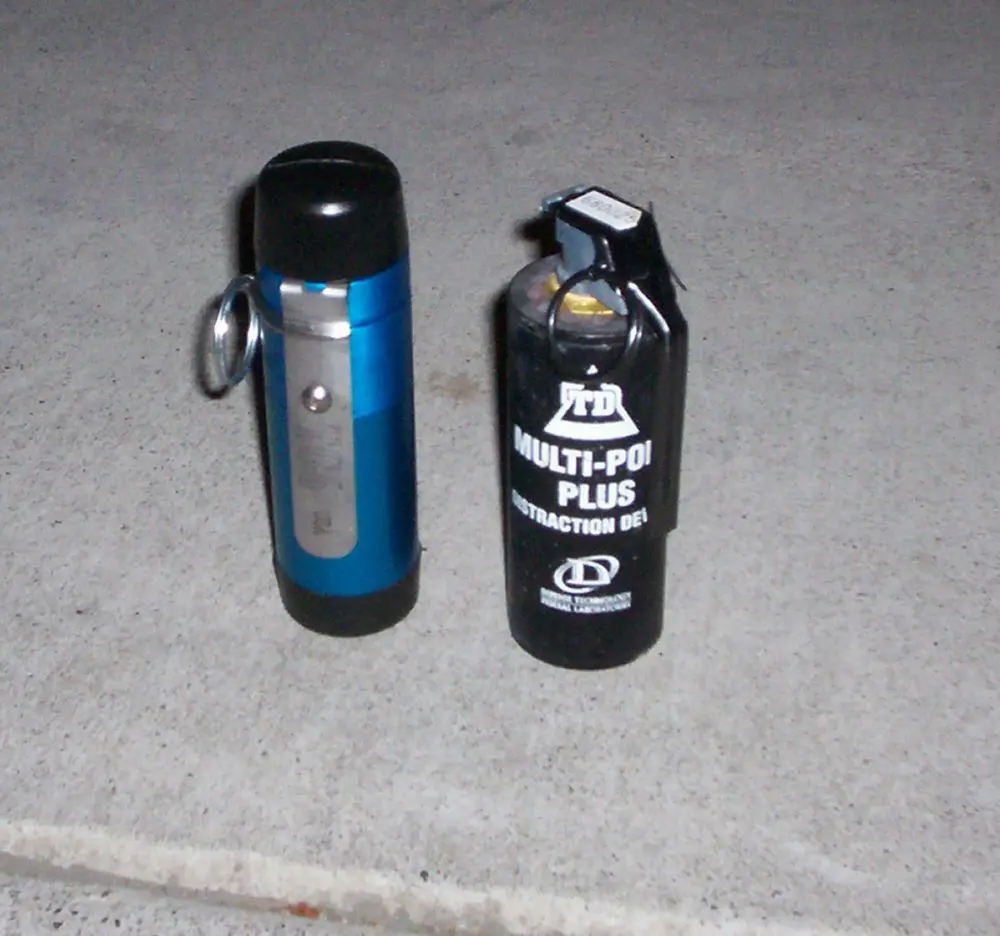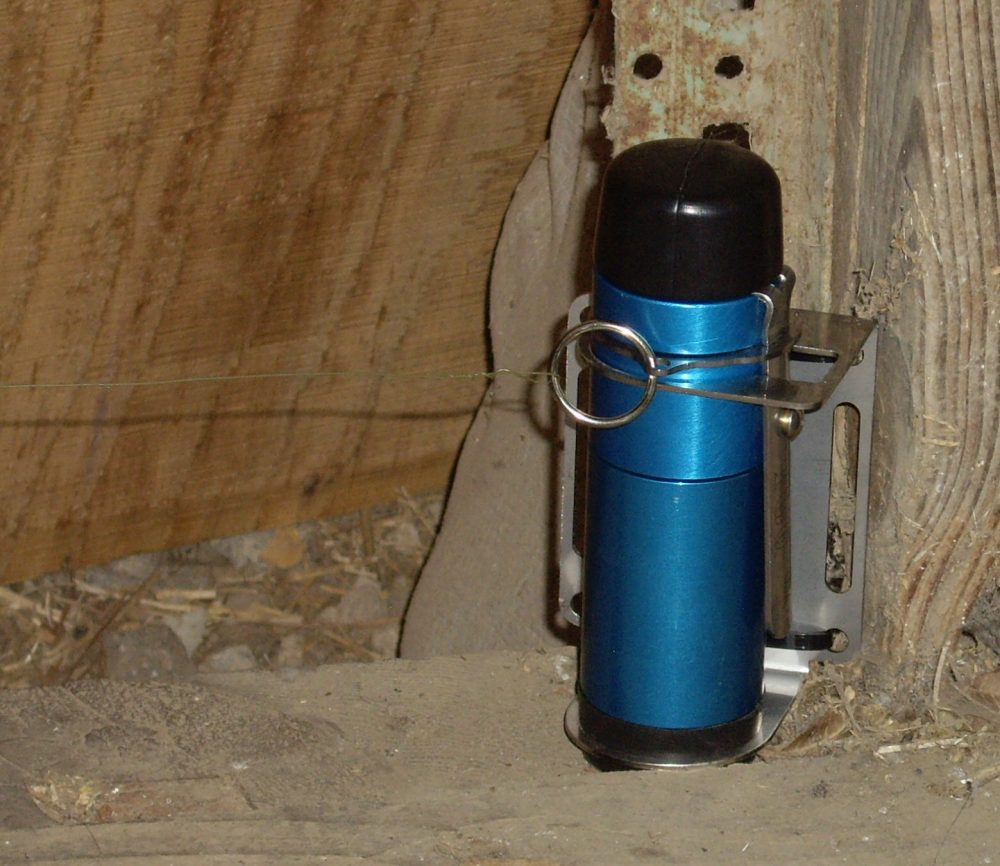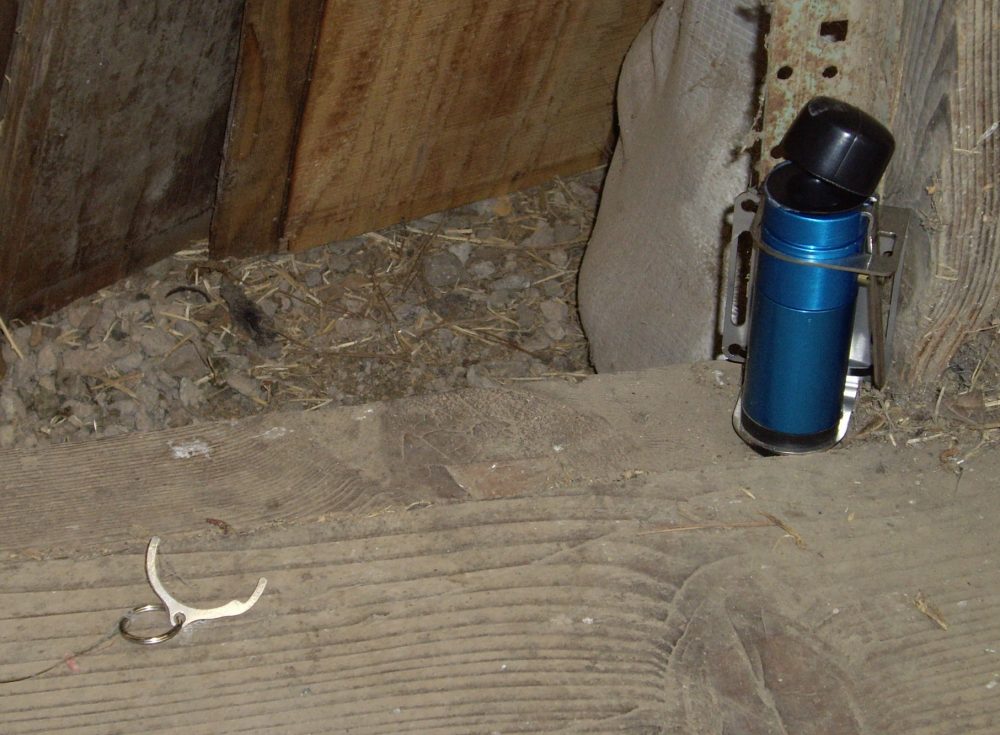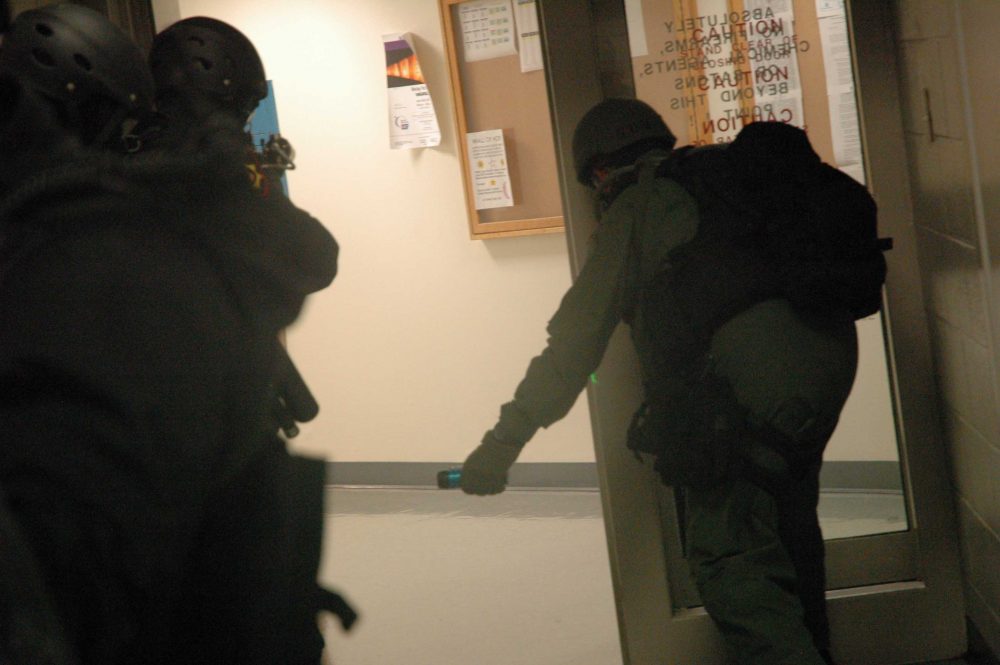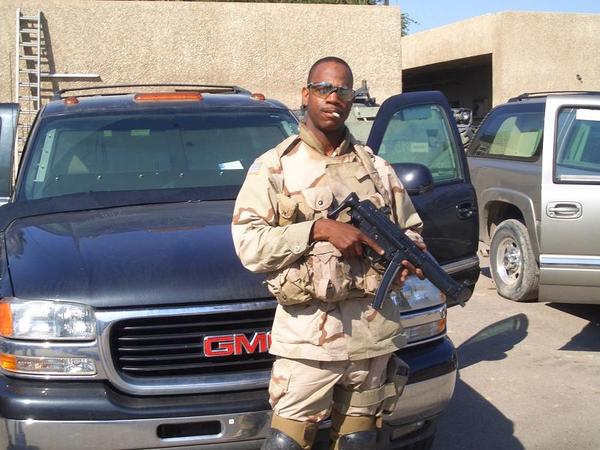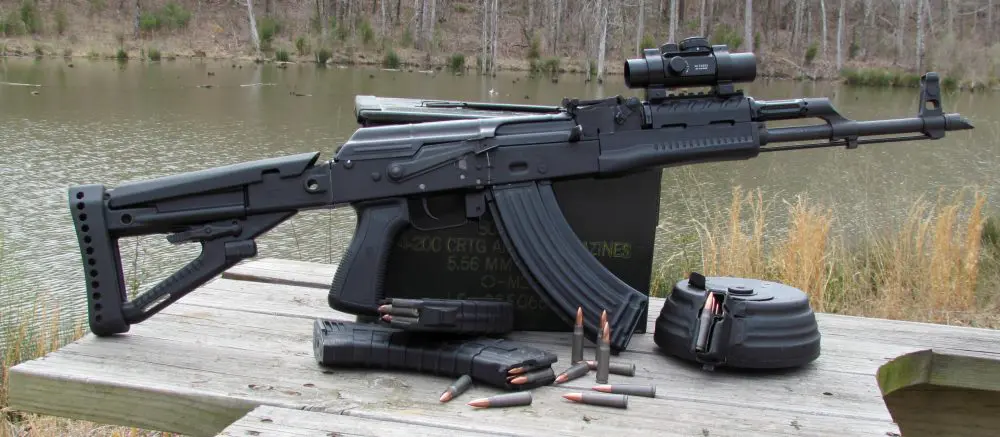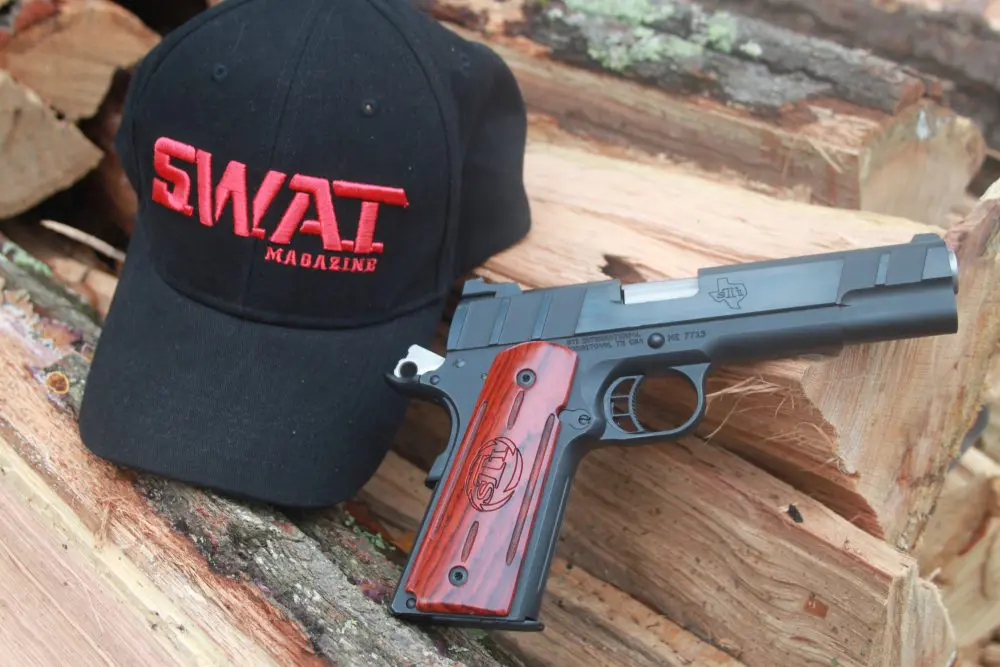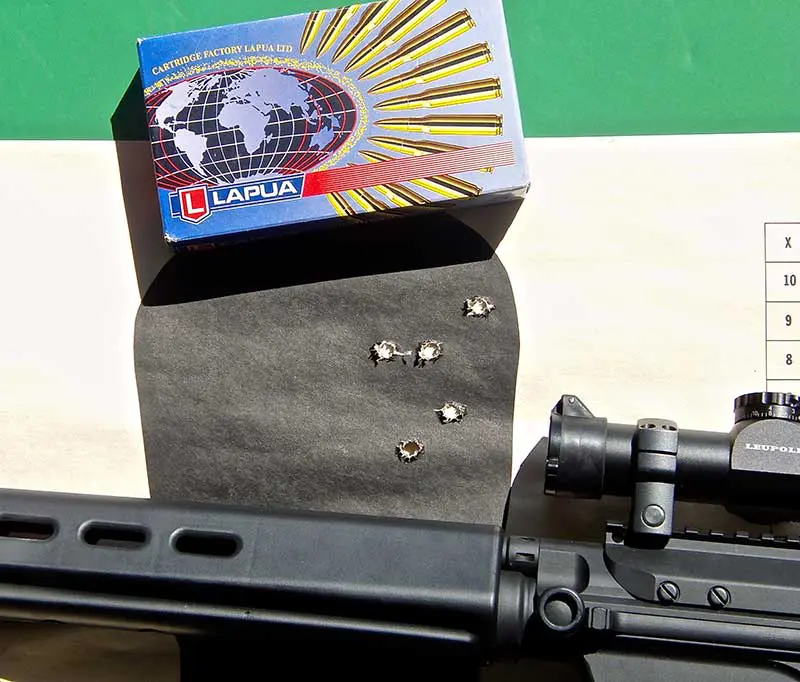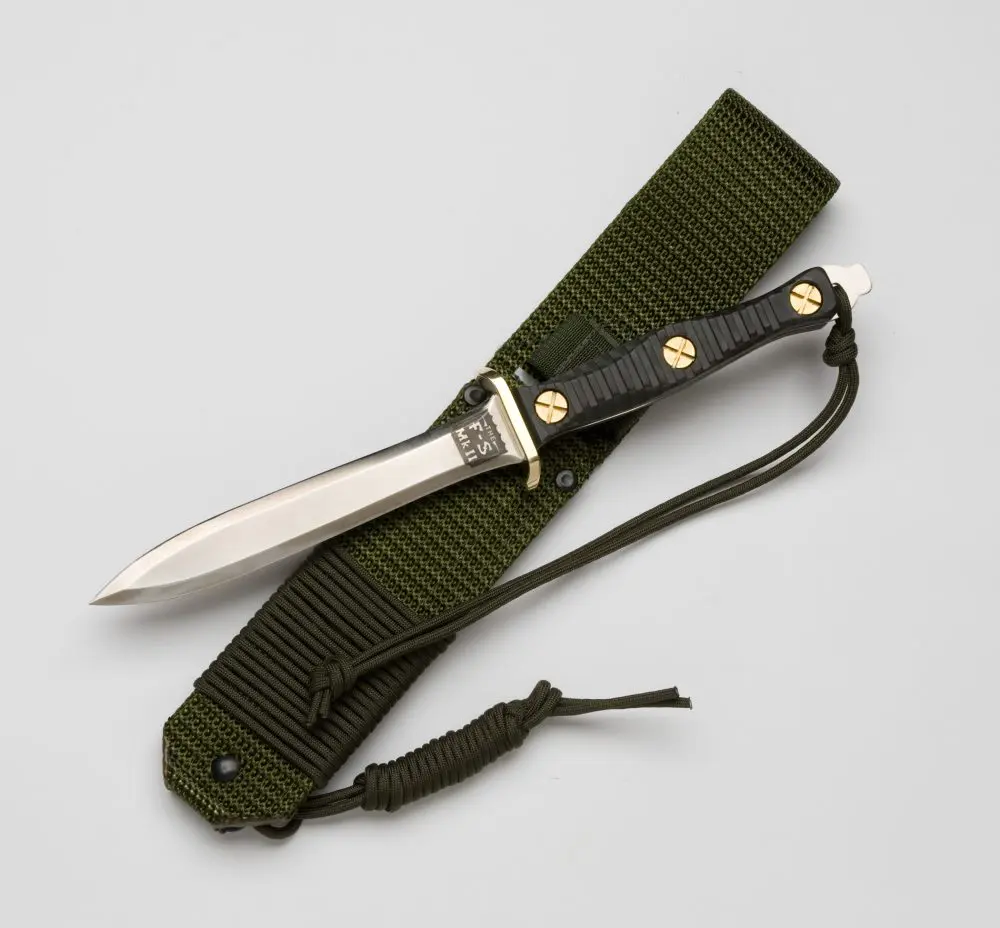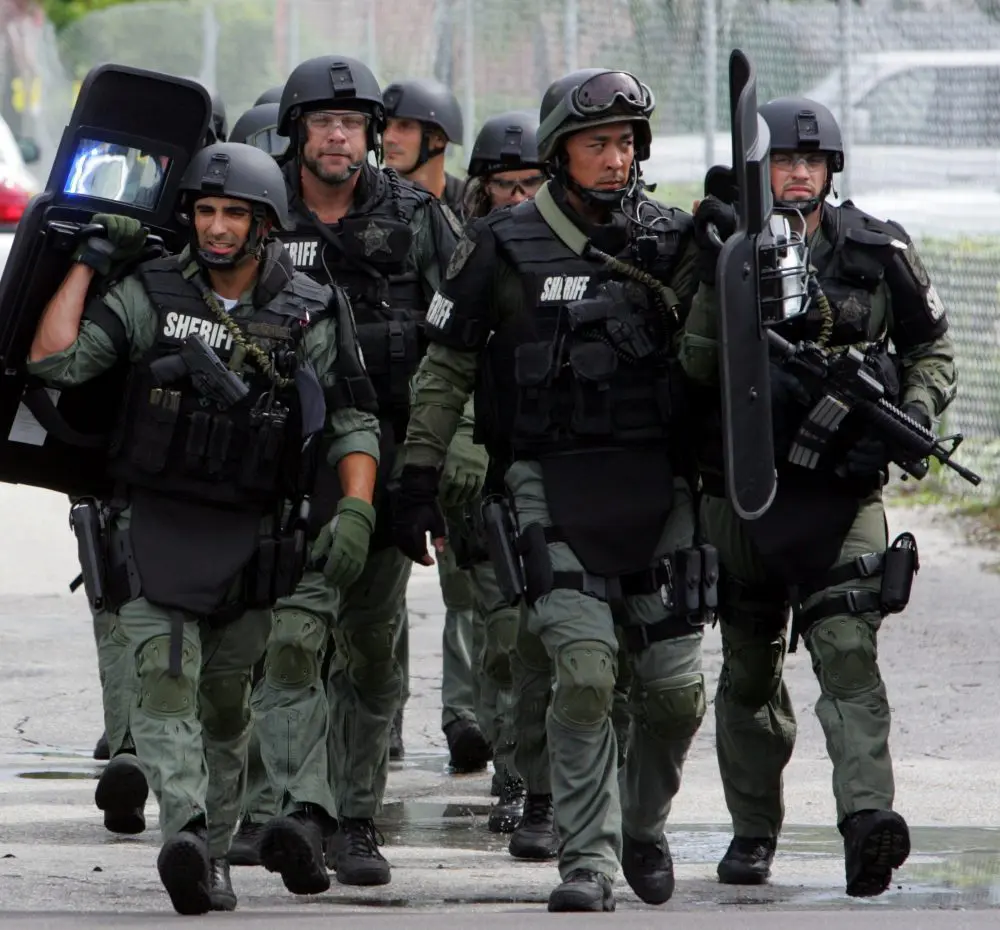Non-Lethal Training Munitions TG 6 shown with my department’s standard Def-Tec Multi-Port Plus distraction device. Size is very close, meaning that it can be used from the pouches that are already possessed.
They are known as flash bangs, bangs, noise/flash diversionary devices, distraction devices and I’d imagine one or two other names.
After early uses by the Israelis at Entebbe, the West Germans in Mogadishu and the British at Princes Gate, the idea of using a very bright and loud noise to distract the Bad Guys before coming through their door spread to American law enforcement tactical teams. Over time, they have migrated from national special-mission units down to conventional Infantry units and from big-city SWAT elements down to part-time SWAT teams as well as narcotics units. Regardless of who is deploying them, training in their use and employment should be viewed as mandatory.
Booby trap kit with TG 6 was emplaced easily using pre-drilled holes on the mount. The fit of mount and TG 6 was good. Nice to see a manufacturer thinking about dual-use products for training, given budgetary issues for most governmental agencies.
Table of Contents
Why Train with Flash Bangs?
Why train with them? Legal liability is a fact of life. Every jurisdiction seems to have attorneys who can’t wait to sue the trousers off agencies and/or individual officers. Sadly, that is more of a driving force than the obvious: If you are going to use a tool in a real world high-risk situation, you had better get used to using it before it is “for real.”
Until recently, the only way to train for using these devices was with either a live device or a down-loaded training version. Both have a cost factor associated with them, along with other concerns related to explosive devices.
So how have these concerns been overcome? Recently Andrew Van DerPlaats at Non-Lethal Training Munitions (NLTM), LLC, contacted S.W.A.T. Magazine about a new offering of theirs: the Thumper TG 6 Training Grenade. They describe the TG 6 as a non-pyrotechnic, re-usable flash bang-style training device. It is.
Complete TG 6 training grenade consists of lower body with rubber bumper, CO2 canister, upper body with spoon, bursting diaphragm, safety clip with pull ring, rubber “O” ring and hex wrench.
TG 6: Construction and Assembly
The construction of the device is relatively simple but solid. The main body consists of two pieces of machined aluminum stock. The bottom portion houses an eight-gram CO2 canister and has a rubber base attached to it. The upper portion contains a valve, a rubber “O” ring and the spoon. The top of the upper portion is milled to accept a bursting plastic diaphragm. The spoon is held in a closed, or compressed, position by a safety clip. This is a machined circle clip that rides on the spoon and in a channel milled around the upper portion of the body. This clip has a split ring attached for use as a pull ring.
Assembly is simple. After ensuring that the threads and the milled area for the bursting diaphragm are free of dirt and grit, place an eight-gram CO2 cartridge tip up in the open center of the bottom portion. Make sure the spoon is compressed and held in place by the safety clip. Next, screw the upper portion into the lower portion. Finally, set the bursting diaphragm in the milled opening, depress it and twist it a quarter-turn clock-wise. NLTM has marked the top of the diaphragm with the correct direction.
When assembled, the overall dimensions of the TG 6 are 1.75 inches in diameter with a height of 6 inches. The total weight is one pound.
Booby trap clip comes off much easier than standard safety clip. It worked well in booby trap mode, but the spoon hung slightly in the mount’s slot as a result of being twisted when activated.
The Big Bang
To use the TG 6, grasp the split ring attached to the safety clip. Pull the ring, release the spoon and expect the “bang” caused by the bursting diaphragm about one and a half seconds later. When the spoon is released, the CO2 canister is punctured and its contents fill the bursting diaphragm. Once the diaphragm’s capacity has been exceeded, it bursts, which creates the “bang.” It is a fairly sharp report.
So, what are the uses of the TG 6? It’s most obviously use is in the force-on-force environment. Preventing damage to your role players is a good thing. Additionally, there are locations where you need to train which, by their very nature, limit, if not outright preclude, the use of actual diversionary devices. Some examples are courthouses and other governmental buildings, commercial buildings with large amounts of glass, and new, not yet occupied residential construction.
Also, new-user training can be expanded upon with a non-pyrotechnic device. The industry standard is to visually clear any area into which a diversionary device is going to be inserted. That can be trained for and practiced with the TG 6.
Members of Solano County, California, Sheriff’s Department special weapons team using TG 6 during entry training. Note that the environment—with glass display cases—is not where you’d likely get approval to deploy a functional device strictly for training purposes. Photo courtesy Non Lethal Training Munitions, LLC.
Field Testing
Is there a projectile concern from the bursting diaphragm with these? Kind of, though that is not a definitive answer. During the initial throw testing, my partner and I placed one of these about four feet from a concrete foundation with the bursting diaphragm pointed toward it. When the diaphragm burst, as intended, the detached portion hit the concrete and bounced back about 18 to 24 inches before coming to rest. Later, I initiated the TG 6 from a raised position. It was aimed at a half-inch-thick piece of residential sheetrock from about 18 inches away. Following the burst, the detached portion of the diaphragm hit the sheetrock and bounced off without any detectable damage to the sheetrock.
Over-pressure is a concern when using any type of explosive in a confined space or interior environment. When it comes to the TG 6, the question is “What overpressure?” Since the device has no explosive component, this is not an issue. There is no glass or fire hazard with it either.
One of the two diversionary device Subject Matter Experts in my department is currently my patrol supervisor. I had him in a ten-foot-square room for a test deployment. He commented that, while it was not as loud as he had expected, it was quite sufficient for the intended purpose. He had expected an over-pressure issue and was pleasantly surprised that there was none.
This article is dedicated to Shakere Guy, assigned to the 1/184IN (AASLT) as a gunner. He was killed in action by an IED in southern Baghdad on 29 October 2005 and posthumously promoted to Sergeant. Rest in peace, brother.
Bonus Booby Trap
Non-Lethal Training Munitions designed a trip wire-initiated booby trap component to go with the TG 6. It consists of a mounting bracket, a four-strand wire spool, wire ties, a booby trap clip and directions. The booby trap clip is significantly smaller than the standard safety and comes with a noticeably smaller pull ring on it. This smaller clip is significantly easier to dislodge, making it ideal for the booby trap role.
The one concern I noted with the booby trap feature was binding the spoon in the bracket. This took place when the bracket was set up in such a way that the booby trap clip turned the device in the bracket when the trip wire was pulled. When this happened, the device functioned, but did not seem to burst as quickly.
During the course of testing, I found two diaphragms that were rather difficult to seat. In comparing them to other diaphragms, I noted that there was no visible difference. They seated fine when I put them in place prior to inserting the CO2 canister and closing the two halves of the body.
Parts, Instructions and Costs
The manufacturer specifically recommends being cautious of dirt and grit and ensuring that, when the TG 6 is used in areas with them, that you clean it well before reassembling it. From our experience throwing these in a dirt parking lot, I concur with them. Just clean the threads and machined areas as needed.
Both the TG 6 training grenade and the booby trap kit come with clear, easy to use instructions.
Cost is always a consideration in purchasing training items. The TG 6 works to the end user’s advantage. A complete basic kit goes for $119.95 and the booby trap kit costs $39.95. A 12 pack of bursting diaphragms and CO2 canisters plus two replacement “O” rings is $59.85. There is also a 72 pack of diaphragms, canisters and replacement “O” rings available. Comparing the 12 pack cost to the cheapest reload price I could find on the web, it showed Saf-T-Bang and Titan distraction device reloads at $10 each in a 10 pack, but that was a four-year-old price list and it does not take into account spoons, strikers, pins and springs.
Non-Lethal Training Munitions, LLC, catalogs spare parts, including a carry pouch, and has them available.
If you or your agency employs noise/flash diversionary devices, you know that you need to train with them regularly. The TG 6 is a very viable option for initial and force-on-force training as well as booby trap simulation—especially if cost is a consideration.
SOURCE:
Non-Lethal Training Munitions, LLC
Dept. S.W.A.T.
3444 Marinatown Lane, Suite 23
North Ft. Myers, FL 33903
(407) 563-3884
